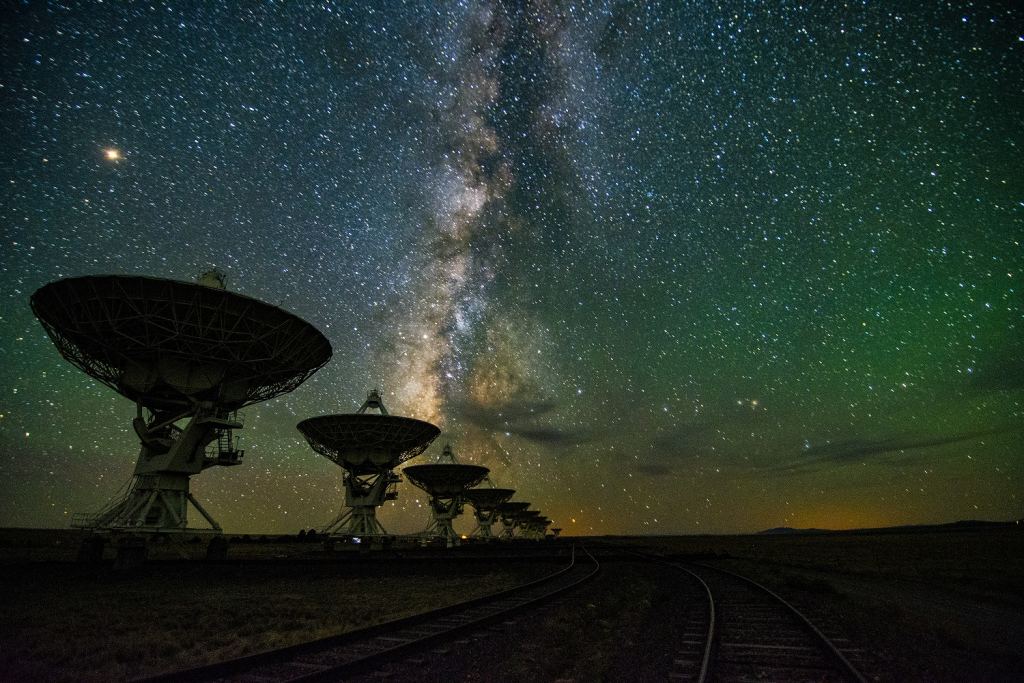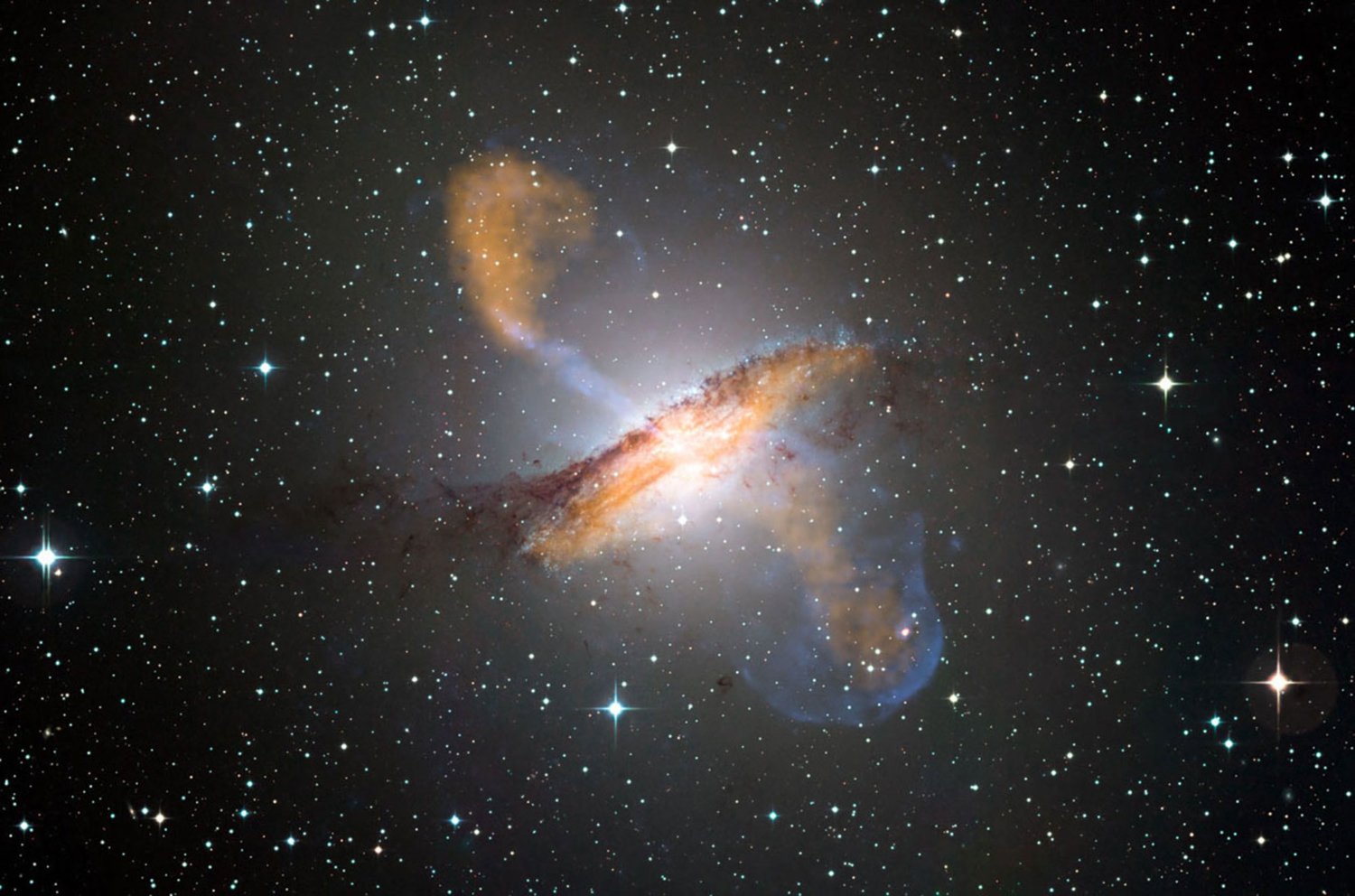For decades, scientists engaged in the Search for Extraterrestrial Intelligence (SETI) have probed the galaxy for signs of artificial radio transmissions. Beginning with Project Ozma in 1960, astronomers have used radio antennas to listen for possible transmissions from other star systems or galaxies. These efforts culminated in January 2016 with the launch of Breakthrough Listen, the most comprehensive SETI effort to date. This project combines radio wave observations from the Green Bank and Parkes Observatory, as well as visible light observations from the Automated Planet Finder (APF),
The results of Breakthrough Listen’s surveys have been shared via a series of public releases. The latest series, “Artificial Broadcasts as Galactic Populations,” authored by Brian C. Lacki, explores the possibility that galaxies that are bright in the radio spectrum (aka. “radio bright” galaxies) could be an indication that such galaxies could be packed with advanced civilizations. The latest paper examines how future SETI surveys could detect radio broadcasts individually or collectively and sets bounds on the artificial radio galaxy population using both methodologies.
Brian C. Lacki is a theoretical astronomer with the Breakthrough Listen Initiative and a Jansky Fellow with the National Radio Astronomy Observatory (NRAO). The paper is the third in a series that explores the latest data provided by the Initiative’s affiliated observatories. The paper describing Lacki’s findings recently appeared online and has been submitted for publication to the Publications of the Astronomical Society of the Pacific.
 This illustration shows what the activities of a Kardashev Type III civilisation might look like. Credit: Danielle Futselaar / ASTRON.
This illustration shows what the activities of a Kardashev Type III civilisation might look like. Credit: Danielle Futselaar / ASTRON.
This paper is the third in a series that addresses technosignatures of an entire population of ETIs, rather than individual star-bound civilizations. As Lacki explained, the series was partly motivated by the idea that ETIs might rely on self-replicating (Von Neumann) probes to explore and settle beyond their star systems. This theory is foundational to the “Fermi Paradox,” which assumes that this method is the most likely way advanced civilizations will become interstellar and (possibly) galactic. The first paper presents the theory and a mathematical framework for the calculations conducted in the second and third papers.
In the second, Lacki explores what happens when you have multiple broadcasting civilizations in a single galaxy and applies this understanding to the Milky Way, Andromeda (M31), and Messier 59 (NGC 4621). The latest paper examines the potential signatures that a population of advanced civilizations would produce in galaxies throughout the Universe. “If you have some subset that has a lot of radio transmissions, they will appear radio-bright,” Lacki told Universe Today via email. “Since we know basically how many galaxies there are at each level of flux, we can set upper limits on how many of these ‘artificial radio galaxies’ there are.”
Galaxies are known to produce radio waves as part of their natural emissions. This includes Sagittarius A*, the supermassive black hole (SMBH) at the center of our galaxy. During the 1970s, scientists discovered that the bright radio emissions at the center of our galaxy were caused by an extremely compact object embedded within a larger radio source. Since then, astronomers have determined that SMBHs reside at the center of every massive galaxy and are responsible for Active Galactic Nuclei (AGNs), a phenomenon in which the core region of a galaxy temporarily outshines all the stars in the galactic disk.
However, artificial radio broadcasts would initially be indistinguishable from natural sources, and a galaxy containing multiple civilizations that rely on radio technology would naturally appear brighter. In addition, many transmitting civilizations could overlap, making it very difficult to identify a single source. However, it would also be possible to detect the collective glow of these combined transmissions. Said Lacki:
[T]he trouble is that you can’t tell whether that emission is natural or artificial just from knowing how bright it is in the radio (and we expect it is natural in almost all, if not all, cases). For an individual galaxy, all you can do is set an upper limit based on the total radio emission, which I call “the collective bound”. If you’re applying the collective bound to an individual galaxy, you actually want to look for galaxies that are as faint in the radio as possible while still having a large number of stars. But in this paper, we are considering all the galaxies in the Universe, and it turns out that radio-bright galaxies are pretty rare, so you can set an upper limit on what fraction of galaxies have lots and lots of radio transmissions.
 Artist’s impression of Breakthrough Listen listening for broadcasts from space. Credit: Breakthrough Initiatives
Artist’s impression of Breakthrough Listen listening for broadcasts from space. Credit: Breakthrough Initiatives
To set limits on the number of possible ETIs in radio galaxies, Lacki employed a small set of models that tested the effect of different basic assumptions. Each model considered the nature of the “metasociety” (expansive or “galactic hub”) and societies involved (diffuse or discrete), the evolution of their transmissions, their luminosity distribution, set bounds on the radio frequencies used, and a broad power law. These were paired with a base set describing a scenario where every galaxy has one metasociety, the broadcasts do not evolve, and all have a single luminosity.
Based on these models, Lacki determined that the abundance of galaxy-spanning civilizations (Kardashev Type III) radio broadcast populations is than one in 1017 stars, and one in a million large galaxies. As he detailed:
Of course, it’s possible that every galaxy has artificial radio transmitters at some level. We don’t even know if the Milky Way has radio-broadcasting ETIs, which is why we do SETI surveys in our own Galaxy. We can make statements about how much power ETIs could be putting into radio, and for that, it can be helpful to use the Kardashev scale: a Type I society uses the power available to a planet; a Type II society uses the power available to a star; a Type III society uses the power available to a galaxy. Kardashev originally proposed that it be used to measure the amount of power going into broadcasts.
What my work shows is that Type IIIs in this original sense – ETIs that broadcast the luminosity of an entire galaxy in radio waves – are very rare. Less than 1 in 100,000 galaxies the size of the Milky Way can host one, and that appears to be a robust result, whether the power is put into one single broadcast or spread among a billion. And at most about 1 in 100 large galaxies could host a Kardashev Type 2.75, with ETIs broadcasting about 1/300th of a galaxy’s luminosity in radio.
In this respect, Lacki likens searching for civilizations in radio-bright galaxies to GHAT surveys and other searches for Dyson Spheres. These searches look for sources of excess infrared radiation, which would (in theory) be caused by heat radiated to space by the Dyson shell. In the same way, astronomers could search for galaxies with “too much” infrared emissions, though this would present similar problems. How would SETI surveys distinguish between artificial and natural infrared sources?
 The Karl G. Jansky Very Large Array in New Mexico. Credit: VLA
The Karl G. Jansky Very Large Array in New Mexico. Credit: VLA
According to Lacki, there is the collective method he described, while the other involves looking for individual radio broadcasts that could stand out in the radio spectrum of the galaxy:
In the past few years, various researchers have been setting upper limits on radio transmissions in other galaxies by looking for ones that just happen to be near stars that we are observing in SETI and might be caught by luck. This is still an important strategy, and what you’d want to do is to look at as much of the sky as possible, as deeply as possible, at as many frequencies as possible.
You can also directly target nearby galaxies themselves, and this is being done more in recent years. For this collective method, using radio surveys to limit the fraction of “artificial radio galaxies”, we already basically know how many galaxies there are at each brightness in the radio (“source counts”). What you could do is apply the method to other frequencies, and set limits on how many ETIs there are that are broadcasting in those.
In recent years, SETI researchers have sought to expand the list of potential technosignatures future surveys could look for. Befittingly, Lacki added that these same surveys could also search for technosignatures beyond radio frequencies, such as X-rays, gamma rays, and other non-radio, non-optical transmissions. In fact, he recommends that these surveys could be a good starting point for new SETI surveys that look beyond the radio domain.
Further Reading: arXiv

